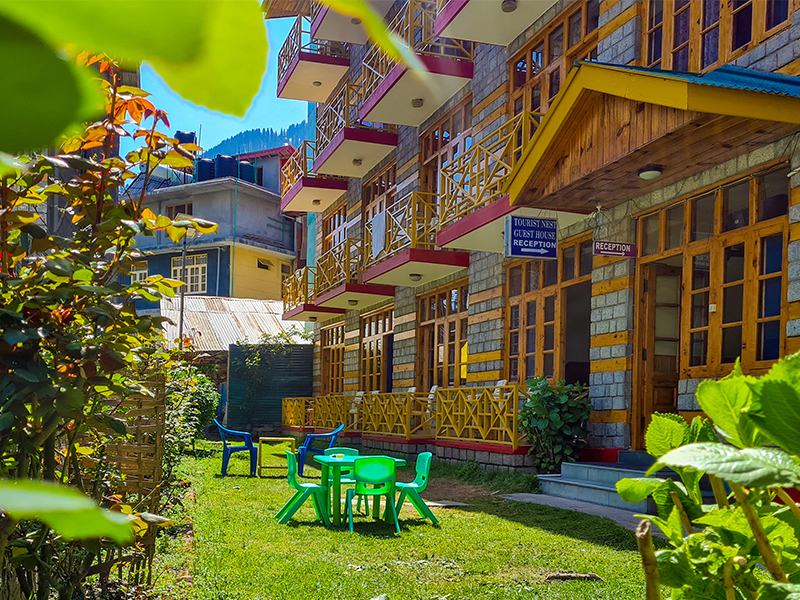


Vashisht is a quaint village near Manali in the state of Himachal Pradesh, India, renowned for its ancient temples, hot springs, and picturesque surroundings. The history of Vashisht is deeply intertwined with Hindu mythology and legends, making it a place of religious significance and cultural heritage.
According to Hindu mythology, Vashisht is named after Rishi Vashisht, one of the Saptarishis (seven revered sages) in ancient Indian scriptures. Rishi Vashisht is revered for his wisdom, piety, and role as a teacher and counselor to numerous gods and kings. Legends say that he meditated in the serene surroundings of Vashisht, making it a place of spi ...



.jpg)



.webp)





.webp)


Packages Of Manali
Enjoy mountains, adventure and cosy stays in the heart of Himachal.

Places To Visit In Manali
Top places to visit in Manali, perfectly explored.
.webp)
Blogs Of Manali
Where Himalayan adventure meets tranquil valleys
.webp)
Images Of Manali
Explore the magic of Manali through breathtaking images
Packages Of Manali
Places To Visit In Manali
Blogs Of Manali
Images Of Manali
Vashisht, a serene village near Manali in Himachal Pradesh, India, holds a special charm with its blend of spirituality, natural beauty, and cultural heritage. Here are the top things to know about Vashisht:
Vashisht is named after Sage Vashisht, one of the Saptarishis (seven great sages) in Hindu mythology. The village is renowned for the Vashisht Temple dedicated to him, which dates back to ancient times. The temple attracts pilgrims and devotees seeking blessings and spiritual solace amidst the Himalayan tranquility.
One of the main attractions of Vashisht is its natural hot springs, known as Vashisht Kund. These sulfur-rich springs are believed to have medicinal properties and are frequented by visitors seeking therapeutic benefits for skin ailments and joint pains. The hot springs have a mythological connection as well, associated with Lord Rama's purification rituals.
Vashisht boasts traditional Himachali architecture characterized by stone and wood structures, intricate carvings, and sloping slate roofs. The village retains its old-world charm with narrow cobblestone lanes, terraced fields, and ancient temples, providing a glimpse into the region's rich cultural heritage.
Surrounded by lush greenery, snow-capped mountains, and the gushing Beas River nearby, Vashisht offers ample opportunities for nature lovers and adventure enthusiasts. Activities include trekking, hiking, exploring nearby forests, and enjoying panoramic views of the Himalayas.
Visitors to Vashisht can immerse themselves in local culture through traditional music and dance performances, religious rituals at the Vashisht Temple, and interactions with friendly villagers. The village hosts various festivals throughout the year, providing insights into Himachali traditions and customs.
Located just a few kilometers from Manali, Vashisht is easily accessible by road. Visitors can reach the village by local buses, taxis, or even on foot from Manali, enjoying scenic views along the way.
Food enthusiasts can savor authentic Himachali cuisine in Vashisht, including specialties like siddu (a type of stuffed bread), maahni (black gram curry), and various dishes made from locally grown vegetables. The village also has cafes and eateries offering stunning views of the surrounding mountains.
Above all, Vashisht is known for its serene ambiance and tranquil surroundings. Away from the bustling tourist spots, the village offers a peaceful retreat where visitors can unwind, meditate, or simply enjoy the beauty of nature.
As tourism grows in Vashisht, there is a concerted effort to promote sustainable and responsible tourism practices. Visitors are encouraged to respect local customs, conserve natural resources, and support the livelihoods of the local.
Best time to visit vashisht is in the morning as it is a spritual place. And if we talk about seasonal time to visit this place then it will be from march to june and November to mid January.
Vashisht is a quaint village near Manali in the state of Himachal Pradesh, India, renowned for its ancient temples, hot springs, and picturesque surroundings. The history of Vashisht is deeply intertwined with Hindu mythology and legends, making it a place of religious significance and cultural heritage.
According to Hindu mythology, Vashisht is named after Rishi Vashisht, one of the Saptarishis (seven revered sages) in ancient Indian scriptures. Rishi Vashisht is revered for his wisdom, piety, and role as a teacher and counselor to numerous gods and kings. Legends say that he meditated in the serene surroundings of Vashisht, making it a place of spiritual importance.
Vashisht is also mentioned in ancient Indian texts such as the Ramayana and the Mahabharata, adding to its historical significance. These epics describe the region as a place where sages performed penance and where significant events in the lives of deities and heroes took place.
The Vashisht Temple, dedicated to Rishi Vashisht, is the focal point of the village. This ancient temple is constructed in traditional Himachali style, with intricate wood carvings and a pagoda-style roof. Inside the temple, there are idols of Rishi Vashisht and Lord Rama, further connecting it to the epic Ramayana.
Another prominent feature of Vashisht is its natural hot springs, known as Vashisht Kund. These hot water springs are believed to have medicinal properties and are frequented by pilgrims and tourists seeking healing and relaxation. The water is rich in sulfur, which is said to have therapeutic benefits for skin ailments and joint pains.
Vashisht village retains its traditional charm with old stone and wood houses, narrow cobblestone lanes, and terraced fields. The architecture reflects the local Himachali style, characterized by sloping slate roofs and intricate wooden carvings. The village also hosts cultural performances and festivals, offering visitors a glimpse into the rich cultural heritage of the region.
In recent decades, Vashisht has become a popular destination for tourists visiting Manali and the surrounding areas. Its serene ambiance, ancient temples, and natural hot springs attract travelers seeking both spiritual rejuvenation and adventure amidst the Himalayan foothills.
Vashisht, a serene village near Manali in Himachal Pradesh, India, is steeped in history and surrounded by natural beauty. Here are some interesting facts about Vashisht:
Historical Significance: Vashisht is named after Rishi Vashisht, one of the seven revered sages (Saptarishis) in Hindu mythology. According to legends, Rishi Vashisht meditated in the tranquil surroundings of this village, making it a place of spiritual importance.
Vashisht Temple: The village is famous for the Vashisht Temple, dedicated to Rishi Vashisht. This ancient temple is constructed in traditional Himachali architectural style, with intricate wood carvings and a pagoda-style roof. It houses idols of Rishi Vashisht and Lord Rama.
Natural Hot Springs: Vashisht is known for its natural hot springs, known as Vashisht Kund. These hot water springs are believed to have medicinal properties due to their high sulfur content, which is said to benefit skin ailments and joint pains. Many pilgrims and tourists visit these springs for therapeutic purposes.
Cultural Heritage: The village retains its traditional charm with old stone and wood houses, narrow cobblestone lanes, and terraced fields. The architecture reflects the local Himachali style, characterized by sloping slate roofs and intricate wooden carvings.
Tourist Destination: Vashisht has become a popular destination for tourists visiting Manali and the surrounding areas. Its serene ambiance, ancient temples, and natural hot springs attract travelers seeking spiritual rejuvenation and relaxation amidst the Himalayan foothills.
Adventure Activities: Apart from its cultural and religious significance, Vashisht offers opportunities for adventure activities such as trekking, hiking, and exploring the nearby forests and hills. The surrounding landscapes provide breathtaking views and a chance to connect with nature.
Local Cuisine: Visitors can savor traditional Himachali cuisine in Vashisht, including dishes like siddu (a type of stuffed bread), maahni (black gram curry), and various preparations of locally grown vegetables. The village also offers cozy cafes and eateries with stunning views of the mountains.
Festivals and Celebrations: Throughout the year, Vashisht hosts cultural performances and local festivals that provide insights into the rich cultural heritage of the region. These celebrations often include traditional music, dance, and religious rituals.
Accessibility: Vashisht is easily accessible from Manali, located just a few kilometers away. Visitors can reach the village by road, either through local transport or by hiring taxis from Manali.
Scenic Beauty: Surrounded by lush greenery, snow-capped mountains, and the Beas River flowing nearby, Vashisht offers spectacular views that attract nature lovers, photographers, and those seeking tranquility amidst natural beauty.

ashisht, nestled in the serene hills near Manali, Himachal Pradesh, is not just a place of natural beauty and religious significance but also a repository of fascinating stories and legends. Here are some intriguing tales associated with Vashisht:
The village of Vashisht derives its name from Sage Vashisht, one of the Saptarishis (seven revered sages) in Hindu mythology. According to legend, Sage Vashisht was one of the mind-born sons of Lord Brahma, the creator of the universe. He was known for his wisdom, knowledge of scriptures, and his role as the guru of Lord Rama and his brothers in the epic Ramayana.
The story goes that Sage Vashisht once undertook deep meditation in the tranquil surroundings of what is now Vashisht village. It is said that the village became a place of spiritual power and tranquility due to his penance and presence.
One of the most renowned aspects of Vashisht is its natural hot springs, known as Vashisht Kund. Legend has it that these hot springs were created by Lord Rama himself. According to the Ramayana, after the devastating loss of his wife Sita, Lord Rama sought solace and purification. He requested Sage Vashisht to help him find a place to perform a yagna (ritual sacrifice) for cleansing. Sage Vashisht, knowing the healing properties of the hot springs, directed Lord Rama to Vashisht. It is said that Lord Rama bathed in these hot springs to cleanse himself of the sins associated with killing Ravana, the demon king.
Since then, the Vashisht Kund has been considered sacred and is believed to have medicinal properties. Pilgrims and visitors come here seeking spiritual rejuvenation and relief from ailments.
Beyond its spiritual and mythological tales, Vashisht also has stories of resilience and cultural heritage. The village has witnessed its share of natural calamities, including landslides and heavy snowfalls. However, the resilient spirit of its inhabitants and their deep connection to the land have helped them rebuild and preserve the traditional Himachali way of life.
Vashisht is a melting pot of cultures, where ancient traditions blend seamlessly with modern influences. The village celebrates various festivals and cultural events throughout the year, offering visitors a glimpse into the rich tapestry of Himachali culture. From traditional music and dance performances to religious rituals at the Vashisht Temple, these events bring the community together and showcase their vibrant heritage.
Modern-day adventurers and nature enthusiasts flock to Vashisht not only for its spiritual ambiance but also for its opportunities for outdoor activities. The surrounding hills and forests offer trekking routes that lead to panoramic viewpoints and secluded valleys. Visitors can embark on hikes to nearby waterfalls or simply explore the wilderness, encountering diverse flora and fauna along the way.
One of the enduring stories of Vashisht is the hospitality and warmth of its residents. Visitors often recount tales of being welcomed into local homes, where they are treated to traditional Himachali cuisine and heartfelt conversations. This hospitality, rooted in the village's cultural ethos, leaves a lasting impression on all who visit Vashisht.
In essence, Vashisht is not just a place on the map but a repository of stories that resonate with spirituality, resilience, cultural richness, and the wonders of nature. Each tale adds to the tapestry of this Himalayan village, making it a destination where myths and legends come alive amidst the breathtaking landscapes of Himachal Pradesh.
The Himalayan Mountains are a majestic mountain range in South Asia, spanning five countries. They boast the world's highest peaks, including Mount Everest. These young, growing mountains feature rugged, snow-capped peaks, deep valleys, and glaciers. The Himalayas influence regional climate, harbor unique biodiversity, and hold cultural and spiritual significance. They attract adventurers, nature lovers, and spiritual seekers from around the world.